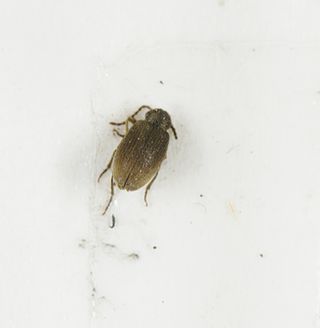Ptinus tectus
Species of beetle From Wikipedia, the free encyclopedia
Ptinus tectus, often called the Australian spider beetle, is a species of beetle in the family Ptinidae,[1] or family Anobiidae, subfamily Ptininae.[2] It is a cosmopolitan species (arrived in Europe and the UK from Australia in 1900). It is a pest of stored foods and museum specimens.
| Ptinus tectus | |
|---|---|
 | |
| Scientific classification | |
| Domain: | Eukaryota |
| Kingdom: | Animalia |
| Phylum: | Arthropoda |
| Class: | Insecta |
| Order: | Coleoptera |
| Suborder: | Polyphaga |
| Family: | Ptinidae |
| Genus: | Ptinus |
| Species: | P. tectus |
| Binomial name | |
| Ptinus tectus Boieldieu, 1856 | |
| Synonyms | |
| |
P. tectus Boieldieu, 1856 is the name most often used for this species. Some works still state Ptinus ocellus Brown, 1929.[3]
Biology
Summarize
Perspective
Description
The Australian spider beetle (Pictus tectus) measures 2.5–4 mm in length and is coloured dark brown. The adults have biting mouthparts, a well developed thorax and 11-segmented antennae. Characteristics which give them a spider-like appearance include a stout body, pronounced constriction of the neck shield and 6 long thin legs with 5-segmented tarsi.[4]
Life cycle
The female Australian spider beetle lays 100–120 sticky eggs over a period of 4–5 weeks in early summer, either singly or in small batches. At 20–25 °C the eggs hatch in 3–16 days, producing larvae which are fleshy, curved, covered with fine hairs and relatively immobile. Larval development takes at least 6 weeks, during which time the larvae moult 4 or 5 times. When mature, they wander in search of a pupation site where they spin a cocoon cell in which to pupate. Adults emerge after 20 to 30 days and will live for as long 12 months.[4]
At 70% R.H. development of Ptinus tectus from egg laying to emergence from the cocoon takes an average of about 62 days at 23–25 °C; at 15 °C the time taken is about 130 days. The minimum temperature at which complete development can occur is 10 °C and the maximum is between 28 and 30 °C. Considerable mortality occurs in eggs and larvae at 28 °C.[5]
Domestic pest
The species is considered as a pest in museums.[6] It is recorded from at least 55 museums and historic houses in the United Kingdom.[7]
References
External links
Wikiwand - on
Seamless Wikipedia browsing. On steroids.
